Film & Movies
10 Things You Should Know About Disney’s Film Version of “Into The Woods”
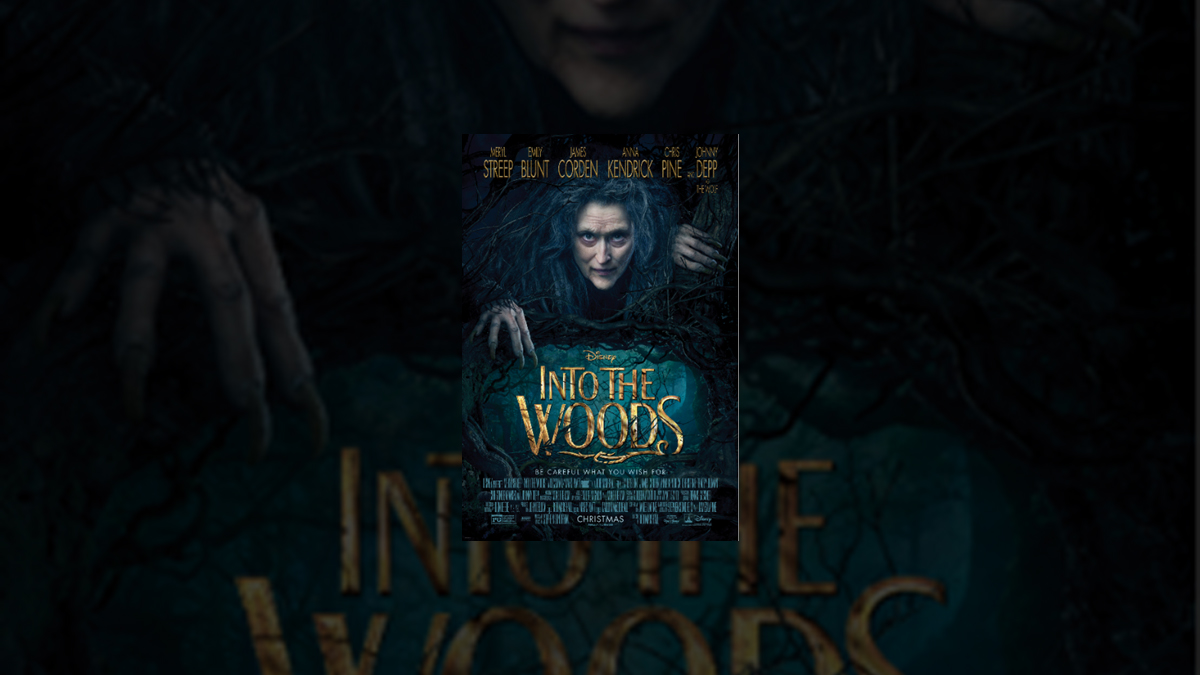

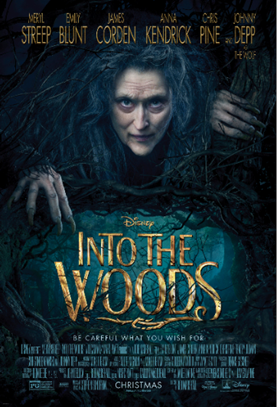
Twelve years ago, following the phenomenal success of the big screen adaptation of the Broadway musical "Chicago" director Rob Marshall sat down with Stephen Sondheim and expressed an interest in directing a film version of one of the legendary composer's stage productions. At the top of Sondheim's list: "Into the Woods," one of his most acclaimed – and poignant – works, and one which he thought would be a perfect fit for Marshall.
Marshall and his producing partner, John Deluca, had been fans of Sondheim and James Lapine's landmark musical since it opened on Broadway in 1987. Together, they took their passion project to Disney, and immediately knew they had found the perfect company to bring the stage musical to life. "They were truly interested in expanding the definition of what a 'modern fairly tale' film could be," says Marshall.
So after 27 years, the long-awaited classic was set to begin its journey forward. "The Woods of our story is universal, and can mean so many things," Marshall says. "It is the place you go to find your dreams, confront your fears, lose yourself, find yourself, grow up and learn to move forward. It's all part of life. So 'Into the Woods' we go, again and again…"
10 THINGS YOU SHOULD KNOW ABOUT THE MAKING OF A LANDMARK MUSICAL INTO A MOVIE:
 Director Rob Marshall was inspired by a speech President Obama made on the 10th Anniversary of 9/11
Director Rob Marshall was inspired by a speech President Obama made on the 10th Anniversary of 9/11
In 2011, on the 10th anniversary of the 9/11 attacks, Marshall heard President Obama addressing the families of the victims. In an effort to console them, Obama said, "You are not alone… No one is alone." The phrase "No One is Alone," which is one of the most moving and memorable songs from "Into the Woods" struck a chord with Marshall and in that moment he knew that the time was finally right to bring the beloved musical to the screen.
"In many ways, I think 'Into the Woods' is a fairy tale for the 21st century post 9/11 generation," Marshall says. "Sondheim and Lapine were way ahead of their time when they wrote it. The comforting knowledge that we are not alone in an unstable world gives us all that glimmer of hope."

Meryl Streep turned down similar Witch roles in the past, but was the first actor to come on board this musical
Speaking about why this Witch is different from those that have come before Meryl Streep said, "I changed my mind when this role came along because this Witch is quite different. First of all, she transforms. Her whole reason for being is to reverse a curse that has been placed on her; she sets in motion all sorts of devices and causes a dramatic upheaval in everybody's lives."
"This is a musical with a brain," she said. "There is an intelligence at work because it is Sondheim and Lapine. It is visually fun and emotionally satisfying, but it also has this other element that engages us as artists and makes us want to bring everything we can to it."

The cast had six weeks of rehearsals to get confident with Sondheim and cows
Director Rob Marshall says, "Since this film is an ensemble piece, it was important for everyone to work together to create a cohesive piece."
"Rob comes from musical theatre and he comes to the project so prepared," Tracey Ullman explains. "During the rehearsals we all sat around and sang and read the material, which is exactly what you do when you are putting on 'a stage show, and when we got to the locations we knew the timings and we could get right into the take."
According to producer John DeLuca, the rehearsal period was not so much about blocking the actors' movements but about getting to know the text and giving the actors the chance to get to know and become confident, with their characters journey. "This was a time when everyone could experiment with their characters and toss around all those different ideas to see what would stick, Musicals were new to a lot of the people, and it's very difficult music. Sondheim's music and lyrics are calculus for actors. It was really a bootcamp they went into. " he says.
"They also had to learn to ride horses and be with the cow," he continued. "We had four cows and you really have to learn where to stand and what to do because cows can have a temperament." Tracey Ullman admitted that she fell in love with the cows while learning to work with them.
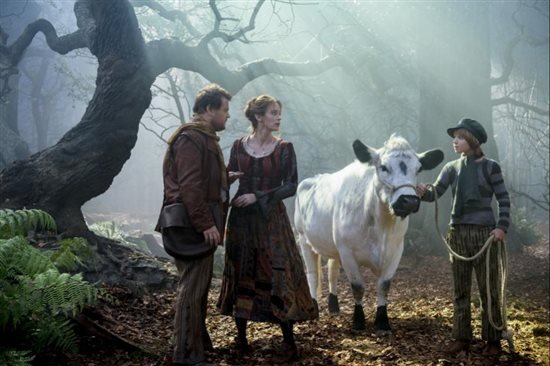
 It was decided early on that the filmmakers would avoid the use of green screens as much as possible
It was decided early on that the filmmakers would avoid the use of green screens as much as possible
Director Rob Marshall: "It was also decided early on that we would avoid the use of green screens as much as possible, because I believe it's harder for actors to imagine themselves in such a specific world when you can't truly visualize where you are. So the majority of our sets were practical sets."
While a good portion of the film was shot on practical locations, there was a substantial amount filmed on sound stages as well. As a result, the filmmakers were constantly having to adapt certain looks, as they would see things on location and would need to modify the sets accordingly.
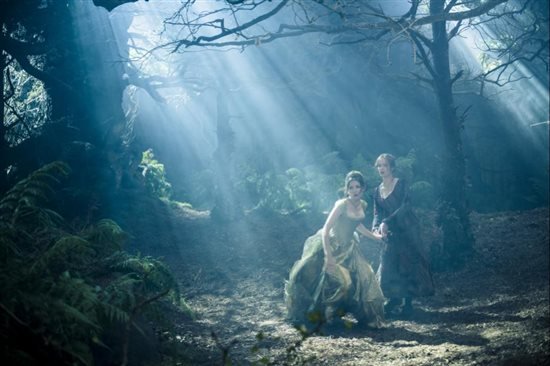
According to producer John DeLuca, "One of our major concerns from day one was how to shoot the film to make our locations in the woods seamlessly blend with our constructed sets. We needed to make the two worlds gel so the audience was never aware, and we had daily conversations about the best way to keep those two worlds as one.

It was Johnny Depp's idea to base his Wolf character on a Tex Avery cartoon character
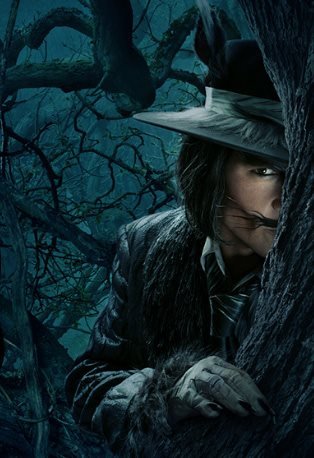
 Rapunzel's single braid was 20 feet long and made of real blonde hair from Germany
Rapunzel's single braid was 20 feet long and made of real blonde hair from Germany
Six pounds of the German hair was hand-woven with very strong cotton and braided into MacKenzie Mauzy's (Rapunzel) real hair. Mauzy spent the entire production, as well as several weeks of pre-production, wearing the braid, as she wanted to be sure it looked as if she'd had it her entire life. "It felt very odd at first, but when it was cut off, I realized I had become strangely attached to it," she says.
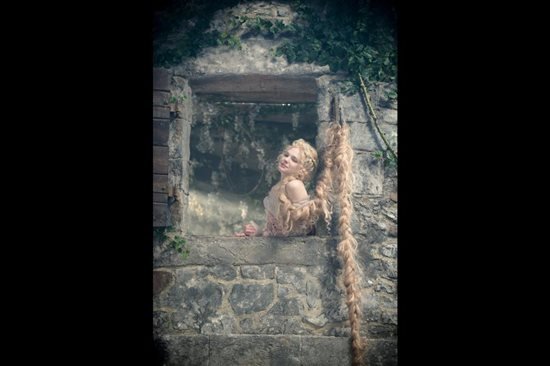
 Location, location, location
Location, location, location
When filmmakers began their initial discussions as to where to shoot the film, it was determined that England's preserved history and enchanting energy was the perfect place to create a world where fairy tale characters come to life, and the country's lush, picturesque landscapes, numerous castles and stately manors offered a wealth of possibilities. And Rob Marshall felt that it made sense to shoot as much on location as possible.
The logistics of filming on location in England in the fall required meticulous planning, as the filmmakers had a small window in which to make the film before winter set in. As a result, all the location work was scheduled early on in the production schedule when there were still leaves on the trees.
Murphy's Law – what can go wrong, will – doesn't care about meticulous planning, however. When a shooting location suddenly became unavailable the movie's producers had to scramble to find a new castle location. Just 3 days before shooting was to begin an English manor owner changed his mind about having the filmmakers on his grounds. The production team did eventually find a suitable location as well as an agreeable property owner. In the end both producers agreed that this new location made the film even better.
 Emily Blunt's (The Baker's Wife) condition was incredibly ironic
Emily Blunt's (The Baker's Wife) condition was incredibly ironic
Emily Blunt: "The Baker's Wife needed to have a sort of slightly-flustered look, and and costume designer Colleen Atwood was masterful at not only creating beautiful costumes, but as hiding the fact that I was pregnant during the shoot, the irony being that I was playing a character who desperately wants a child, while I actually had a child inside me."
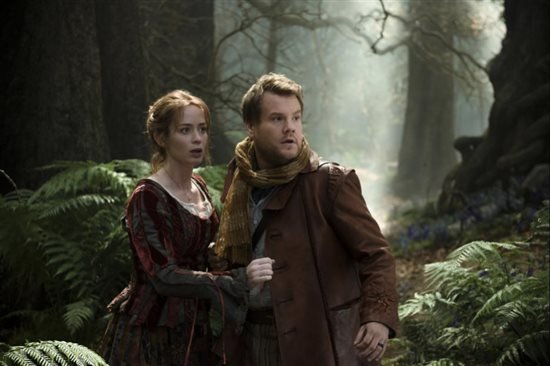

No CGI Lady Giant here. Actress Frances De La Tour stomped her way through a miniature forest set
One of the advantages of bringing a story like Into the Woods" to the big screen is being able to effectively create a world in which the characters live.When the filmmakers defining that world have needs that go beyond the confines of practical sets, that's when visual effects supervisor Matt Johnson steps in.
In "Into the Woods," the visual effects included many of the classical fairy tale elements which are key to the story. Like a computer-generated beanstalk that sprouts up to the sky, a 60-foot giant trampling through a forest, the magic transformation of Cinderella's shabby dress into a beautiful new gown, and the vortex tornado that swirls around the Witch whenever she appears and disappears (something the filmmakers affectionately refer to as "Meryl Magic"). While the effects were computer generated, they still felt very real, because Johnson and his team undersood how it should work and only used the effects when they were truly needed.
The style of computer generation employed was a mixture of old-fashioned practical effects combined with cutting-edge visual effects technology. Johnson explained "Rob is quite fond of many of the old, classic films so we're bringing elements of that into this one. For example, many filmmakers would have wanted the Giant to be a computer-generated creature, but Rob was keen to get an actress (Frances De a Tour) so as to get a really great, human performance."
This feat was accomplished by creating an entire miniature forest with miniature trees for De la Tour to march through, smashing and knocking them over, which is similar to techniques used in 1950's films. But with "Into the Woods," the footage is blended with CGI to provide more of a modern feel.

Chris Pine (Cinderella's Prince) discovered the joy of singing in Rob Marshall's living room
Rob Marshall wanted 'actors that can kind of sing', so when asked what it was like to audition for the role of Cinderella's Prince, Chris Pine replied "I had no idea what 'Into the Woods' was so I had no idea what I was getting into/ But it was Rob Marshall and Meryl Streep so I said yes right away. I had a night to prepare a song to sing in Rob Marshall's living room. I had not sung for anyone but myself and my soap dish so I was terrified.But Rob and John were lovely and understanding and talked with me first about what kind of music I liked then joined me in singing which was great fun. It is just a blast and a great joy and reminded me that what we do is joyful."

Film & Movies
How Disney’s “Bambi” led to the creation of Smokey Bear

When people talk about Disney’s “Bambi,” the scene that they typically cite as being the one from this 1942 film which then scarred them for life is – of course – the moment in this movie where Bambi’s mother gets shot by hunters.
Which is kind of ironic. Given that – if you watch this animated feature today – you’ll see that a lot of this ruined-my-childhood scene actually happens off-camera. I mean, you hear the rifle shot that takes down Bambi’s Mom. But you don’t actually see that Mama Deer get clipped.
Now for the scariest part of that movie that you actually see on-camera … Hands down, that has to be the forest fire sequence in “Bambi.” As the grown-up Bambi & his bride, Faline, desperately race through those woods, trying to find a path to safety as literally everything around them is ablaze … That sequence is literally nightmare fuel.
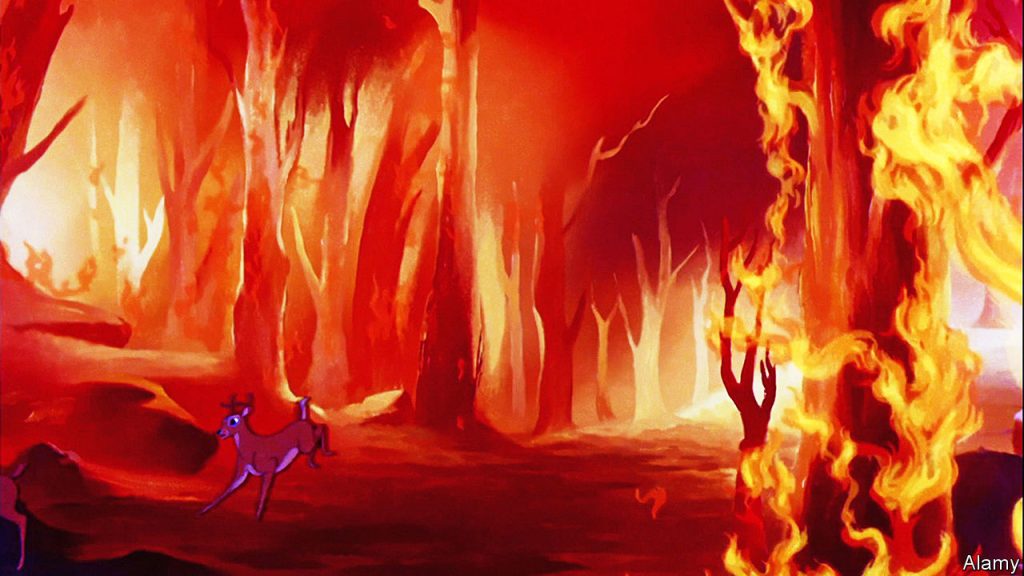
Mind you, the artists at Walt Disney Animation Studios had lots of inspiration for the forest fire sequence in “Bambi.” You see, in a typical year, the United States experiences – due to either natural phenomenon like lightning strikes or human carelessness – 100 forest fires. Whereas in 1940 (i.e., the year that Disney Studios began working in earnest of a movie version of Felix Salten’s best-selling movie), America found itself battling a record 360 forest fires.
Which greatly concerned the U.S. Forest Service. But not for the reason you might think.
Protecting the Forest for World War II
I mean, yes. Sure. Officials over in the Agricultural Department (That’s the arm of the U.S. government that manages the Forest Service) were obviously concerned about the impact that this record number of forest fires in 1940 had had on citizens. Not to mention all of the wildlife habitat that was now lost.
But to be honest, what really concerned government officials was those hundreds of thousands of acres of raw timber that had been consumed by these blazes. You see, by 1940, the world was on the cusp of the next world war. A conflict that the U.S. would inevitably be pulled into. And all that now-lost timber? It could have been used to fuel the U.S. war machine.
So with this in mind (and U.S. government officials now seeing an urgent need to preserve & protect this precious resource) … Which is why – in 1942 (just a few months after the Japanese bombed Pearl Harbor) – the U.S. Forest Service rolls out its first-ever forest fire prevention program.
Which – given that this was the early days of World War II – the slogan that the U.S. Forest Service initially chose for its forest fire prevention program is very in that era’s we’re-all-in-this-together / so-let’s-do-what-we-can-to-help-America’s war-effort esthetic – made a direct appeal to all those folks who were taking part in scrap metal drives: “Forest Defense is National Defense.”

And the poster that the U.S. Forest Service had created to support this campaign? … Well, it was well-meaning as well. It was done in the WPA style and showed men out in the forest, wielding shovels to ditch a ditch. They were trying to construct a fire break, which would then supposedly slow the forest fire that was directly behind them.
But the downside was … That “Forest Defense is National Defense” slogan – along with that poster which the U.S. Forest Service had created to support their new forest fire prevention program didn’t exactly capture America’s attention.
I mean, it was the War Years after all. A lot was going in the country at that time. But long story short: the U.S. Forest Service’s first attempt at launching a successful forest fire prevention program sank without a trace.
So what do you do in a situation like this? You regroup. You try something different.
Disney & Bambi to the Rescue
And within the U.S. government, the thinking now was “Well, what if we got a celebrity to serve as the spokesman for our new forest fire prevention program? Maybe that would then grab the public’s attention.”
The only problem was … Well, again, these are the War Years. And a lot of that era’s A-listers (people like Jimmy Stewart, Clark Gable, even Mel Brooks) had already enlisted. So there weren’t really a lot of big-name celebrities to choose from.
But then some enterprising official at the U.S. Forest Service came up with an interesting idea. He supposedly said “Hey, have you seen that new Disney movie? You know, the one with the deer? That movie has a forest fire in it. Maybe we should go talk with Walt Disney? Maybe he has some ideas about how we can better capture the public’s attention when it comes to our new forest fire prevention program?”
And it turns Walt did have an idea. Which was to use this government initiative as a way to cross-promote Disney Studio’s latest full-length animated feature, “Bambi.” Which been first released to theaters in August of 1942.
So Walt had artists at Disney Studio work up a poster that featured the grown-up versions of Bambi the Deer, Thumper the Rabbit & Flower the Skunk. As this trio stood in some tall grasses, they looked imploring out at whoever was standing in front of this poster. Above them was a piece of text that read “Please Mister, Don’t Be Careless.” And below these three cartoon characters was an additional line that read “Prevent Forest Fires. Greater Danger Than Ever!”
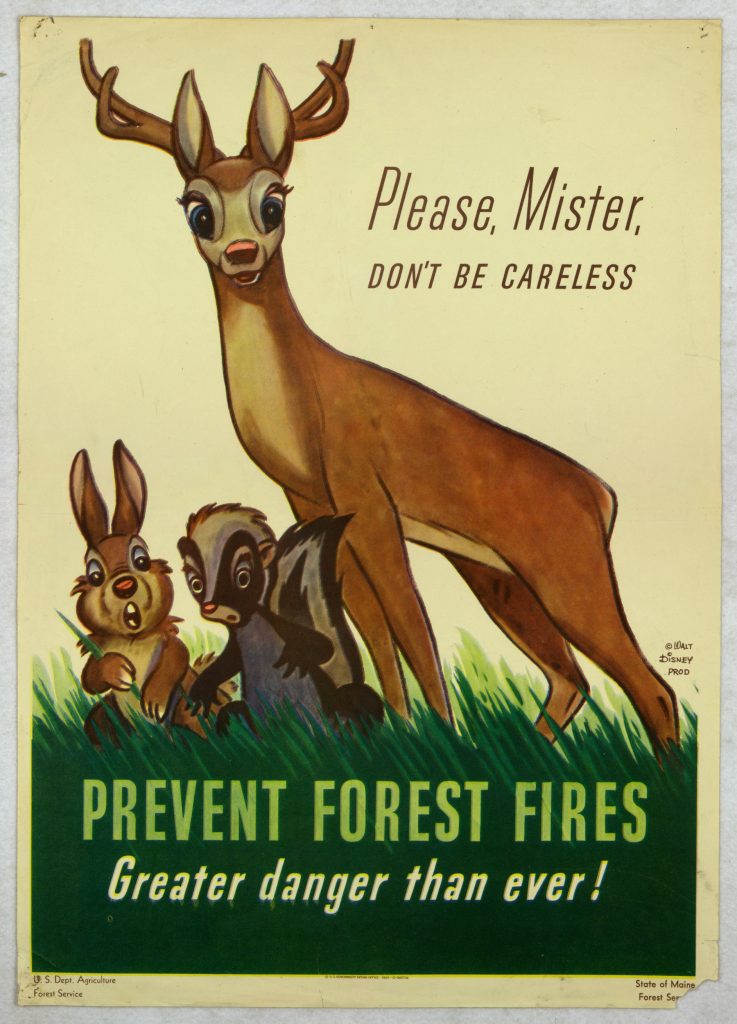
According to folks I’ve spoken with at Disney’s Corporate Archives, this “Bambi” -based promotional campaign for the U.S. Forest Service’s forest fire prevention campaign was a huge success. So much so that – as 1943 drew to a close – this division of the Department of Agriculture reportedly reached out to Walt to see if he’d be willing to let the U.S. Forest Service continue to use these cartoon characters to help raise the public’s awareness of fire safety.
Walt – for reasons known only to Mr. Disney – declined. Some have suggested that — because “Bambi” had actually lost money during its initial theatrical release in North America – that Walt was now looking to put that project behind him. And if there were posters plastered all over the place that then used the “Bambi” characters that then promoted the U.S.’s forest fire prevention efforts … Well, it would then be far harder for Mr. Disney to put this particular animated feature in the rear view mirror.
Introducing Smokey Bear
Long story short: Walt said “No” when it came to reusing the “Bambi” characters to promote the U.S. Forest Service’s forest fire prevention program. But given how successful the previous cartoon-based promotional campaign had been … Well, some enterprising employee at the Department of Agriculture reportedly said “Why don’t we come up with a cartoon character of our own?”
So – for the Summer of 1944 – the U.S. Forest Service (with the help of the Ad Council and the National Association of State Foresters) came up with a character to help promote the prevention of forest fires. And his name is Smokey Bear.
Now a lot of thought had gone into Smokey’s creation. Right from the get-go, it was decided that he would be an American black bear (NOT a brown bear or a grizzly). To make this character seem approachable, Smokey was outfitted with a ranger’s hat. He also wore a pair of blue jeans & carried a bucket.
As for his debut poster, Smokey was depicted as pouring water over a still-smoldering campfire. And below this cartoon character was printed Smokey’s initial catchphrase. Which was “Care will prevent 9 out of 10 forest fires!”
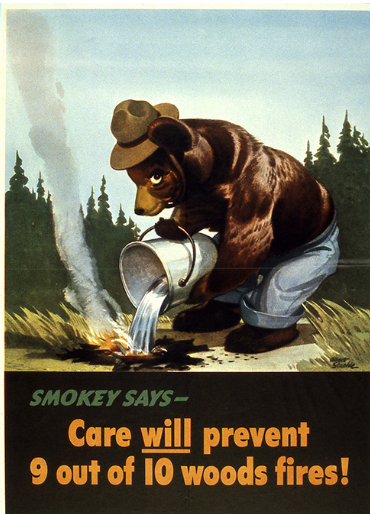
Which makes me think that this slogan was written by the very advertising executive who wrote “Four out of five dentists recommend sugarless gum for their patients who chew gum.”
Anyway … By the Summer of 1947, Smokey got a brand-new slogan. The one that he uses even today. Which is “Only YOU can prevent forest fires.”
The Real Smokey Bear
Now where this gets interesting is – in the Summer of 1950 – there was a terrible forest fire up in the Capitan Mountains of New Mexico. And over the course of this blaze, a bear cub climbed high up into a tree to try & escape those flames.
Firefighters were finally able to rescue that cub. But he was so badly injured in that fire that he was shipped off to the National Zoo in Washington, D.C. and nursed back to health. And since this bear really couldn’t be released back in the wild at this point, he was then put on exhibit.
And what does this bear’s keepers decide to call him? You guessed it: Smokey.
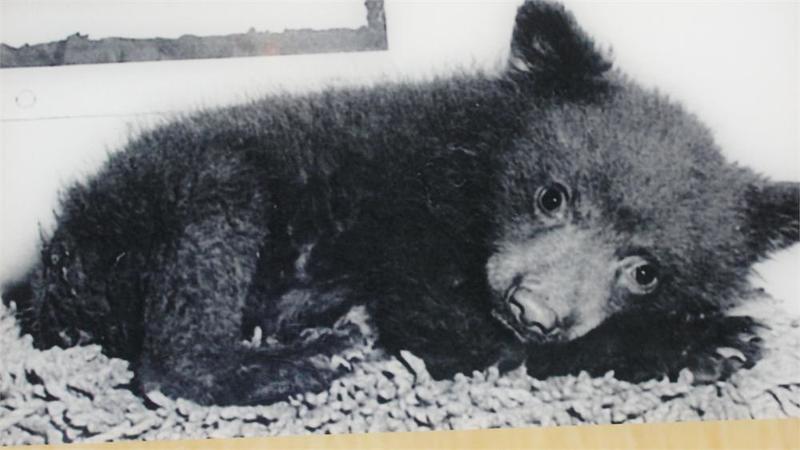
And due to all the news coverage that this orphaned bear got, he eventually became the living symbol of the U.S. Forest Service’s forest fire prevention program. Which then meant that this particular Smokey Bear got hit with a ton of fan mail. So much so that the National Zoo in Washington D.C. wound up with its own Zip Code.
“Smokey the Bear” Hit Song
And on the heels of a really-for-real Smokey Bear taking up residence in our nation’s capital, Steve Nelson & Jack Rollins decide to write a song that shined a spotlight on this fire-fightin’ bruin. Here’s the opening stanza:
With a ranger’s hat and shovel and a pair of dungarees,
You will find him in the forest always sniffin’ at the breeze,
People stop and pay attention when he tells them to beware
Because everybody knows that he’s the fire-preventin’ bear
Believe or not, even with lyrics like these, “Smokey the Bear” briefly topped the Country charts in the Summer of 1950. Thanks to a version of this song that was recorded by Gene Autry, the Singing Cowboy.
By the way, it was this song that started all of the confusion in regards to Smokey Bear’s now. You see, Nelson & Rollins – because they need the lyrics of their song to scan properly – opted to call this fire-fightin’-bruin Smokey THE Bear. Rather than Smokey Bear. Which has been this cartoon character’s official name since the U.S. Forest Service first introduced him back in 1944.
“The Ballad of Smokey the Bear”
Further complicating this issue was “The Ballad of Smokey the Bear,” which was a stop-motion animated special that debuted on NBC in late November of 1966. Produced by Rankin-Bass as a follow-up to their hugely popular “Rudolph the Red-Nosed Reindeer” (which premiered on the Peacock Network in December of 1964) … This hour-long TV show also put a “THE” in the middle of Smokey Bear’s name because the folks at Rankin-Bass thought his name sounded better that way.
And speaking of animation … Disney’s “Bambi” made a brief return to the promotional campaign for the U.S. Forest Service’s forest fire prevention program in the late 1980s. This was because the Company’s home entertainment division had decided to release this full-length animated feature on VHS.
What’s kind of interesting, though, is the language used on the “Bambi” poster is a wee different than the language that’s used on Smokey’s poster. It reads “Protect Our Forest Friends. Only You Can Prevent Wildfires.” NOT “Forest Fires.”
Anyway, that’s how Disney’s “Bambi” led to the creation of Smokey Bear. Thanks for bearin’ with me as I clawed my way through this grizzly tale.
Film & Movies
“Indiana Jones and the Search for Indiana Jones”
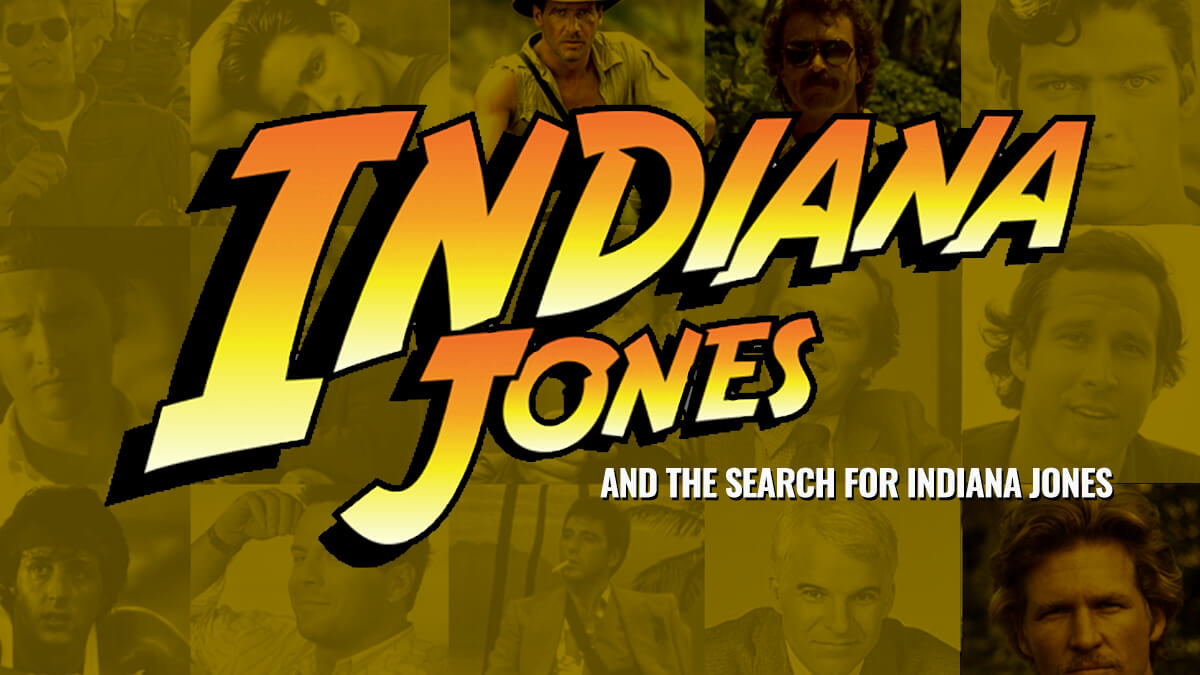
News came late last week that NBC was cancelling the “Magnum PI” remake. This series (which obviously took its inspiration from the Tom Selleck show that originally debuted on CBS back in December of 1980 and then went on run on that network for 8 seasons. With its final episode airing on May 8, 1988).
Anyway … Over 30 years later, CBS decided to remake “Magnum.” This version of the action drama debuted on September 24, 2018 and ran for four seasons before then being cancelled. NBC picked up the “Magnum” remake where it ran for one more season before word came down on June 23rd that this action drama was being cancelled yet again.
FYI: The second half of Season 5 of “Magnum” (10 episodes) has yet to air on NBC. It will be interesting to see when that final set of shows / the series finale gets scheduled.
This all comes to mind this week – out ahead of the theatrical release of “Indiana Jones and the Dial of Destiny” because … Well, if CBS execs had been a bit more flexible back in 1980, the star of the original version of “Magnum PI” (Tom Selleck) would have played the lead in “Raiders of the Lost Ark.” Which was released to theaters back on June 12, 1981.
That’s the part of the Indiana Jones story that the folks at Lucasfilm often opt to skim over.
That Harrison Ford wasn’t George Lucas’ first choice to play Doctor Jones.
Auditions for Indiana Jones – Harrison’s Not on the List
Mind you, Steven Spielberg – right from the get-go – had pushed for Ford to play this part. The way I hear it, Lucas showed Spielberg a work-in-progress cut of “The Empire Strikes Back.” And Steven was so taken with Harrison’s performance as Han Solo in that Irwin Kershner film that he immediately began pushing for Ford to be cast as Doctor Jones.
Whereas Mr. Lucas … I mean, it wasn’t that George had anything against Harrison. What with Ford’s performances first in “American Grafitti” and then in “A New Hope,” these two already had a comfortable working relationship.
But that said, Lucas was genuinely leery of … Well, the sort of creative collaboration that Martin Scorcese and Robert DeNiro. Where one actor & one director repeatedly worked together. To George’s way of thinking, that was a risky path to follow. Hitching your wagon to a single star.
Which is why – when auditions got underway for “Raiders of the Lost Ark” in 1979 — Mike Fenton basically brought in every big performer of that era to read for Dr. Jones except Harrison Ford. We’re talking:
- Steve Martin
- Chevy Chase
- Bill Murray
- Jack Nicholson
- Peter Coyote
- Nick Nolte
- Sam Elliot
- Tim Matheson
- and Harry Hamlin
Casting a Comedian for Indiana Jones
Please note that there are a lot of comedians on this list. That’s because – while “Raiders of the Lost Ark” was in development — Spielberg was directed his epic WWII comedy, “1941.” And for a while there, Steve & George were genuinely uncertain about whether the movie that they were about to make would be a sincere valentine to the movie serials of the 1930s & the 1940s or more of a spoof.
It’s worth noting here that three of the more ridiculous set pieces found in “Temple of Doom” …
- the shoot-out at Club Obi Wan in Shanghai
- Indy, Willie & Short Round surviving that plane crash by throwing an inflatable life raft out of the cargo hatch
- and that film’s mine cart chase (which was not only inspired by Disney theme park favorites the Matterhorn Bobsleds & Big Thunder Mountain Railroad but some of the sound effects that you hear in this portion of “Temple of Doom” were actually recorded after hours at Disneyland inside of these very same attractions)
… all originally supposed to be in “Raiders of the Lost Ark.” I’ve actually got a copy of the very first version of the screenplay that Lawrence Kasdan wrote for the first “Indy” movie where all three of these big action set pieces were supposed to be part of the story that “Raiders” told. And I have to tell you that this early iteration of the “Raiders” screenplay really does read more like a spoof of serials than a sincere, loving salute to this specific style of cinema.
Casting Indiana Jones – Jeff or Tom
Anyway … Back now to the casting of the male lead for “Raiders” … After seeing virtually every actor out in LA while looking for just the right performer to portray Indiana Jones, it all came down to two guys:
- Jeff Bridges
- and Tom Selleck
Jeff Bridges as Indiana Jones
Mike Fenton was heavily pushing for Jeff Bridges. Having already appeared with Clint Eastwood in 1974’s “Thunderbolt & Lightfoot” (Not to mention that “King Kong” remake from 1976), Bridges was a known quantity. But what Fenton liked especially liked about Bridges when it came to “Raiders” was … Well, at that time, Jeff was just coming off “Heaven’s Gate.”
Mind you, nowadays, because we’ve all now had the luxury of seeing the director’s cut of this Michael Cimino movie, we recognize “Heaven’s Gate” for the cinematic masterpiece that it is. But 40+ years ago, that honestly wasn’t the case. All audiences had to judge this movie by was the severely truncated version that United Artists sent out into theaters. Which – because “Heaven’s Gate” had cost $44 million to make and only sold $3.5 million of tickets – then became the textbook example of Hollywood excess.
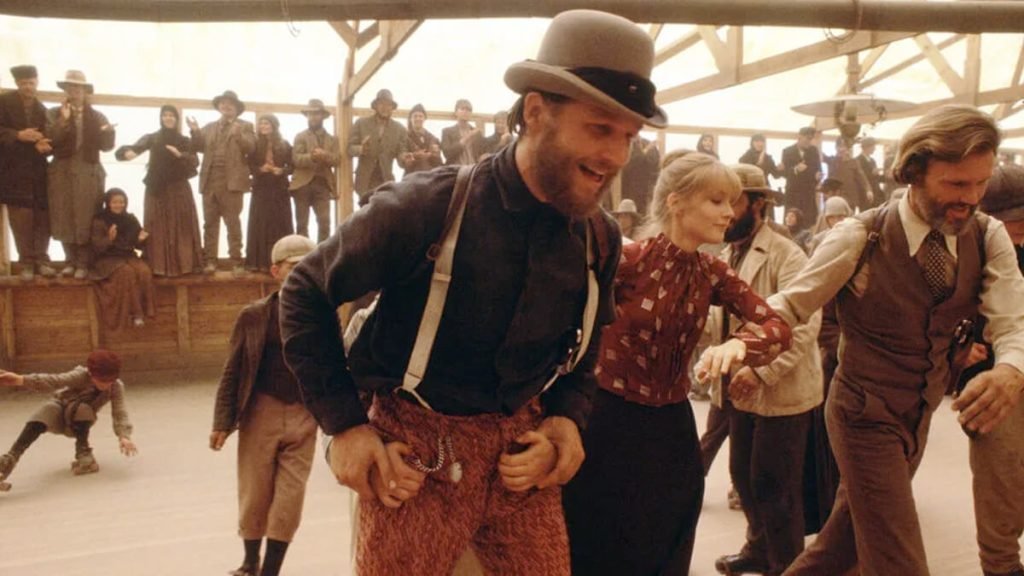
Long story short: Given that being associated with “Heaven’s Gate” had somewhat dinged Bridges’ reputation for being a marketable star (i.e., a performer that people would pay good money to see up on the big screen), Jeff was now looking to appear in something highly commercial. And the idea of playing the lead in a film directed by Steven Spielberg (the “Jaws” & “Close Encounter” guy) and produced by George Lucas (Mr. “Star Wars”) was very, very appealing at that time. Bridges was even willing to sign a contract with Spielberg & Lucas that would have then roped him into not only playing Indiana Jones in “Raider of the Lost Ark” but also to appear as this very same character in two yet-to-be-written sequels.
Better yet, because “Heaven’s Gate” had temporarily dimmed Bridges’ star status, Jeff was also willing to sign on to do the first “Indy” film for well below his usual quote. With the understanding that – should “Raiders of the Lost Ark” succeed at the box office – Bridges would then be paid far more to appear in this film’s two sequels.
That seemed like a very solid plan for “Raiders.” Landing a known movie star to play the lead in this action-adventure at a bargain price.
Ah, but standing in Mike Fenton’s way was Marcia Lucas.
Tom Selleck as Indiana Jones
Marcia Lucas, who had seen Tom Selleck’s audition for “Raiders” (And you can see it as well. Just go to Google and type in “Tom Selleck” and “Indiana Jones.” And if you dig around for a bit, you’ll then see a feature that Lucas & Spielberg shot for “Entertainment Tonight” back in 2008 [This story was done in support of the theatrical release of “Indiana Jones and the Kingdom of the Crystal Skull”]. And as part of this piece, George and Steve share Tom’s original audition for “Raiders.” And what’s genuinely fascinating about this footage is that Selleck’s scene partner is Sean Young. Who – at that time, anyway – was up for the role of Marion Ravenwood) and kept telling her husband, “You should cast this guy. He’s going to be a big star someday.”
And given that George was smart enough to regularly heed Marcia Lucas’ advice (She had made invaluable suggestions when it came to the editing of “American Graffiti” and the original “Star Wars.” Not to downplay George Lucas’ cinematic legacy, but Marcia Lucas was a world-class storyteller in and of her own right), Lucas then reached out to Spielberg and persuaded him that they should cast relative unknown Tom Selleck as Doctor Jones over the already well-known Jeff Bridges.
Now don’t feel too bad for Jeff Bridges. When he lost out on playing the lead in “Raiders of the Lost Ark,” Jeff then accepted a role in the very next, high profile, sure-to-be-commercial project that came along. Which turned out to be Disney’s very first “TRON” movie. Which was eventually released to theaters on July 9, 1982.
Back to Tom Selleck now … You have to remember that – back then – Selleck was the handsome guy who’d already shot pilots for six different shows that then hadn’t gone to series. Which was why Tom was stuck being the guest star on shows like “The Fall Guy” and “Taxi.” Whereas once word got out around town that Selleck was supposed to play the lead in a project that Spielberg was directed & Lucas was producing … Well, this is when CBS decided that they’d now take the most recent pilot that Tom had shot and then go to series with this show.
That program was – of course – the original “Magnum PI.” And it’s at this point where our story started to get complicated.
“Magnum PI” – Two Out of Three Say “Yes”
Okay. During the first season of a TV show, it’s traditionally the network – rather than the production company (which – in this case – was Glen A. Larson Productions. The company behind the original versions of “Battlestar Galactica” & “Knight Rider”) or the studio where this series is actually being shot (which – in this case – was Universal Television) that has all the power. And in this particular case, the network execs who were pulling all the strings behind-the-scenes worked for CBS.
And when it came to the first season of “Magnum PI,” CBS had a deal with Glen A. Larson Productions and Universal Television which stated that the talent which had been contracted to appear in this new action drama would then be available for the production of at least 13 episodes with an option to shoot an additional 9 episodes (This is known in the industry as the back nine. As in: the last nine holes of a golf course).
Anyway, if you take those initial 13 episodes and then tack on the back nine, you then get 22 episodes total. Which – back in the late 1970s / early 1980s, anyway – was what a full season of a network television show typically consisted of.
Anyway … The contract that Selleck had signed with Glen A. Larson Productions, Universal Television & CBS stated that he had to be available when production of Season One of “Magnum PI” began in March of 1980. More to the point, Tom also had to be available should CBS exercise its option to air 22 episodes of this new series on that television network over the course of “Magnum PI” ‘s first season.
Which then made things complicated for George Lucas & Steven Spielberg because … Well, in order for “Raiders of the Lost Ark” to make its June 12, 1981 release date, that then meant that production of the first “Indy” movie would have to get underway no later than June 23, 1980.
But here’s the thing: Production of Season One of “Magnum PI” was scheduled to run through the first week of July of that same year (1980). So in order for Tom Selleck to play Indiana Jones in “Raiders,” he was going to need to be wrapped on production of “Magnum PI” by June 22, 1980 at the absolute latest.
So Spielberg & Lucas went to Glen A. Larsons Productions and asked if Selleck could please be sprung from his “Magnum PI” contractual obligations by June 22nd. And they said “Yes.” Then Steven & George went to Universal Television and asked executives there for their help in clearing Tom’s schedule so that he’d then be available to start work on “Raiders.” And they say “Yes” as well.
Spielberg & Lucas now go to CBS. But instead of the quick “Yeses” that they got from officials at Glen A. Larson Productions and Universal Television, it takes those suits at the Tiffany Network weeks before they then decided to say “No, they couldn’t release Tom Selleck early to go work on ‘Raiders’ “ because …
I’ve never really been able to get a straight answer here as to why CBS execs dug in their heels here. Why they flat-out refused to release Selleck early from his “Magnum PI” contractual obligation and allow him to go shoot “Raiders.”
Payback from “The Star Wars Holiday Special” Trash Talk
That said, it is worth noting that “The Star Wars Holiday Special” aired on CBS back in November of 1978. And given that – in the years that followed — Lucas wasn’t exactly shy when it came to saying how much he hated that two hour-long presentation (Or – for that matter – how George really regretted caving into the requests of CBS execs. Who had insisted that television stars long associated with the Tiffany Network – people like Art Carney, Harvey Korman & Bea Arthur – be given prominent guest starring roles in “The Star Wars Holiday Special”). And I’ve heard whispers over the years that CBS executives preventing Tom Selleck from appearing in “Raiders” could be interpreted as the Tiffany Network getting some payback for what George had said publicly about the “Star Wars Holiday Special.”
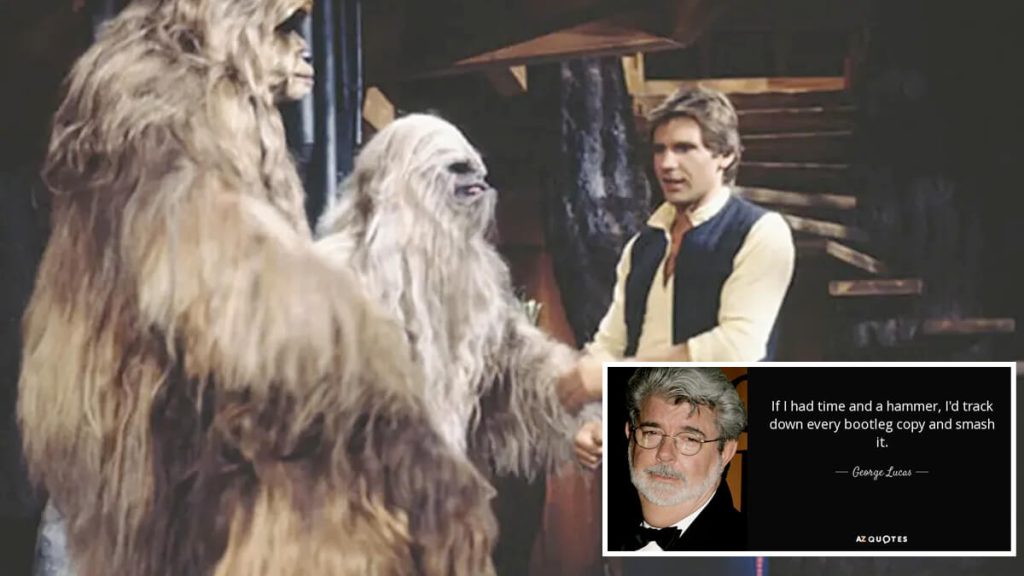
Harrison Ford Comes to Rescue “Indiana Jones”
Anyway … It’s now literally just weeks before production of “Raiders of the Lost Ark” is supposed to begin and Spielberg & Lucas have just learned that that they’ve lost their film’s star. CBS is flat-out refusing to release Tom Selleck early from his “Magnum PI” contractual obligation. So Steven & George now have to find someone else to play Indy … and fast.
The real irony here is … The American Federation of Television and Radio Artists would go on strike in the Summer of 1980. Which then shut prematurely shut down production of the first season of “Magnum PI.” (As a direct result, the first full season of this action drama to air on CBS only had 18 episodes, rather than the usual 22). And because this job action lasted ‘til October 23rd of that same year … Well, this meant that Tom Selleck would have actually been free to start shooting “Raiders of the Lost Ark” on June 23, 1980 because production of Season One of “Magnum PI” was already shut down by then due to that AFTRA strike.
But no one knew – in May of 1980, anyway – that this job action was going to happen in just a few weeks. All that Steven Spielberg & George Lucas knew was that they now needed a new lead actor for “Raiders.” And circling back on Jeff Bridges was no longer an option. As I mentioned earlier, Jeff had agreed to do “TRON” for Disney. And – in the interim – Bridges gone off to shoot “Cutter’s Way” for MGM / UA.
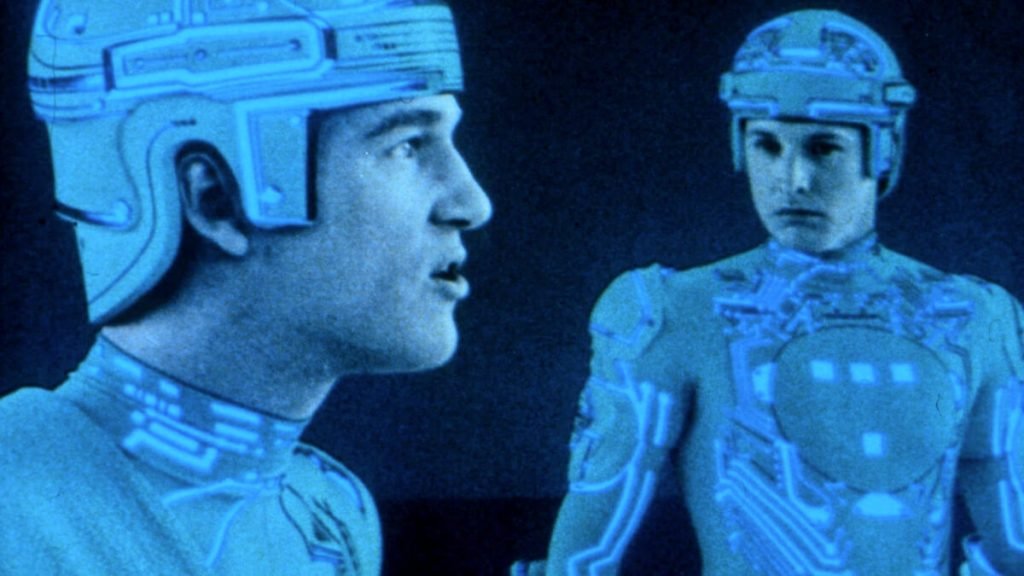
So this is where Harrison Ford enters the equation. As he recalls:
In May of 1980, I get a call from George Lucas. Who says ‘I’m messaging a script over to you this morning. As soon as it gets there, I need you to immediately read this script. Then – as soon as you’re done – I need you to call.
So the script arrives and it’s for ‘Raiders.’ I read it and it’s good. So I call George back and say ‘It’s good.’ And he then says ‘Would you be interested in playing Indy?’ I say that it looks like it would be a fun part to play.
George then says ‘ That’s great to hear. Because we start shooting in four weeks. Now I need you to meet with Steven Spielberg today and convince him that you’re the right guy to play Indy.’
Of course, given that Spielberg had been pushing for Ford to pay Indy ever since he had first seen that work-in-progress version of “The Empire Strikes Back” … Well, Harrison’s meeting with Steven was very, very short. And just a few weeks later, Spielberg, Lucas & Ford were all at the Port de la Pallice in La Rochelle. Where – on the very first day of shooting on “Raiders” (which – again – was June 23, 1980)– the scene that was shot was the one where that Nazi sub (the one that Indy had lashed himself to its periscope by using his bullwhip as a rope) was arriving at its secret base.
And all of this happened because Harrison immediately agreed to do “Raiders of the Lost Ark” when the part of Indy was first offered to him in mid-May of 1980.
Before “Star Wars” was “Star Wars”
So why such a quick yes? Well, you have to remember that “Empire Strikes Back” wouldn’t be released to theaters ‘til May 21, 1980. And no one knew at that time whether this sequel to the original “Star Wars” would do as well at the box office as “A New Hope” had back in 1977 (FYI: “Empire” would eventually sell over $500 million worth of tickets worldwide. Which is roughly two thirds of what the original “Star Wars” earned three years earlier).
More to the point, the four films that Harrison had shot right after “A New Hope” / prior to “Empire Strikes Back” (i.e., “Heroes” AND “Force 10 from Navarone” AND “Hanover Street” AND “The Frisco Kid”) had all under-performed at the box office. So to Ford’s way of thinking, taking on a role that Tom Selleck was no longer available to play – one that had the potential of spawning two sequels – seemed like a very smart thing to do. Especially after three years of cinematic stumbles.
By the way, whenever this topic ever comes up, Harrison Ford is very gracious. He always makes a point of saying that he’s grateful to have gotten this career opportunity. More to the point, that he still feels kind of bad that Tom Selleck never got the chance to play this part.
Tom Selleck After “Indiana Jones”
That said, we shouldn’t feel too bad for Tom Selleck. After all, the original “Magnum PI” proved to be a long running hit for CBS. And in an effort to smooth over any residual bad feelings that may have resulted from Tom being forced to give up “Raiders” back in May of 1980, Selleck was eventually allowed to create his own production company (i.e., T.W.S. Productions, Inc. As in Thomas William Selleck Productions). Which – after the fact – was then cut in on some of those “Magnum PI” -related revenue streams.
More to the point, while “Magnum PI” was on hiatus following its second year in production, Selleck flew off to Yugoslavia. Where he then shot his own Indiana Jones-esque film for theatrical release. Which was called “High Road to China” in the States, but – overseas – was promoted as “Raiders of the End of the World.”
FYI: Warner Bros. released “High Road to China” stateside 40 years ago this year. On March 18, 1983, to be exact. It didn’t do all that great at the box office. $28 million in ticket sales versus $15 million in production costs.
And over the years, there’s even been some talk of finding a way to maybe set things right here. By that I mean: Finally finding a way to officially fold Tom Selleck into the world of Indiana Jones.
Could Tom Selleck Work with Indiana Jones?
The way I hear it, between the time when “Indiana Jones and the Last Crusade” was theatrically released in May of 1989 and when “Indiana Jones and the Kingdom of the Crystal Skull” debuted in May of 2008, there were a number of ideas for Indiana Jones sequels tossed around. And from what I’ve been told, there was at least one treatment for a fourth Indiana Jones film written that proposed pairing up Harrison Ford & Tom Selleck. With the idea here being that Selleck was supposed to have played Ford’s brother.
Obviously that film was never made. And – no – I don’t know what state Indiana Jones’ brother was supposed to be named after.
This article is based on research for Looking at Lucasfilm “Episode 80”, published on June 29, 2023. Looking at Lucasfilm is part of the Jim Hill Media Podcast Network.
Film & Movies
Will “Metro” – that “Cars” Spin-Off Which Disney Developed – Ever Get Made?
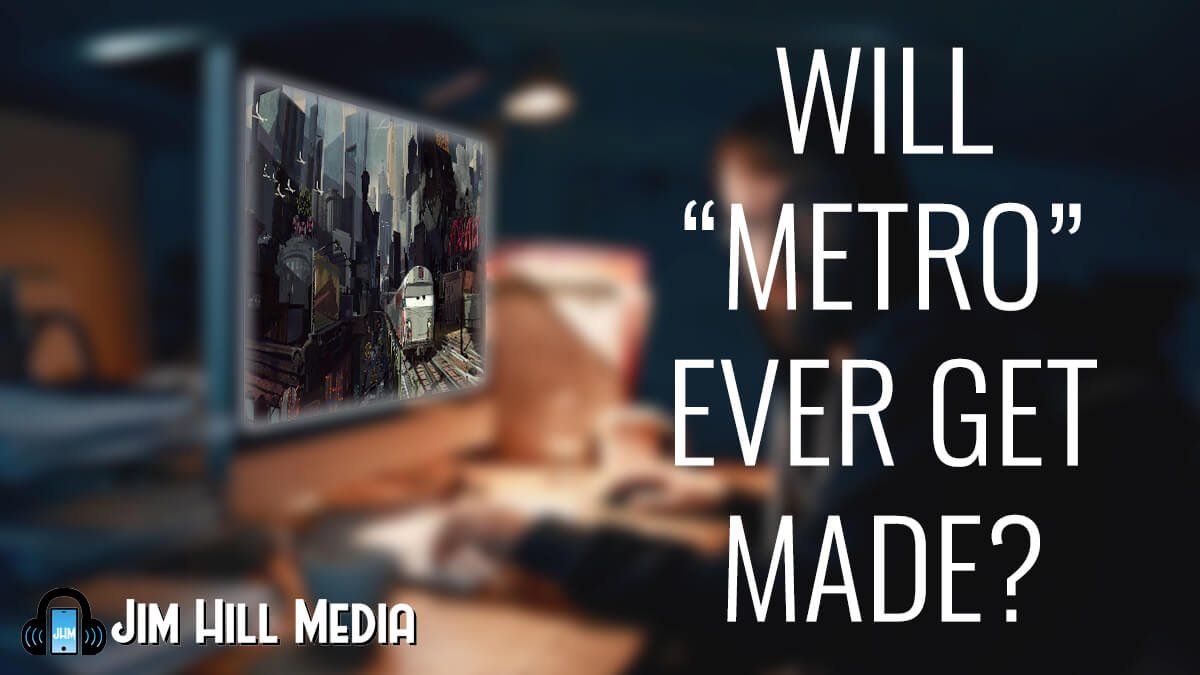
First came “Cars” in June of 2006.
This Pixar Animation Studios production did so well (Of all the high grossing films released that year, “Cars” was No. 2 at the box office. Only “Pirates of the Caribbean: Dead Man’s Chest” sold more tickets in 2006) that Disney execs asked John Lasseter to develop a sequel.
“Cars 2” came out in June of 2011 and also did quite well at the box office (It took the No. 7 slot in the Top-Ten-for-ticket-sales that year). Which is why Disney then asked Pixar to prep a follow-up film.
“Cars 3” would eventually arrive in theaters in June of 2017. But in the meantime, Disney & Pixar began exploring the idea of expanding this film franchise. Largely because the amount of money that the Mouse was making off of the sales of “Cars” -related merchandise was … To be blunt here, mind boggling.
Don’t believe me? Well, then consider this: In just the first five years that the “Cars” film franchise existed, global retail sales of merchandise related to these Pixar movies approached $10 billion. That’s billion with a “B.”
So is it any wonder that – while Pixar was still trying to get a handle on what “Cars 3” would actually be about – the Mouse (through its DisneyToon Studios arm. Which produced home premieres like those “TinkerBell” movies) began actively looking into ways to expand this lucrative franchise?
“Planes” – The First “Cars” Spin-Off
The first “Cars” spin-off to arrive in the marketplace was “Planes.” This Klay Hall film (which was set in “The World Above Cars”) was released theatrically in August of 2013, with the Blu-ray & DVD version of “Planes” hitting store shelves in November of that same year.
“Planes: Fire and Rescue” followed in the Summer of 2014. And while a “Planes 3” was definitely put in development (At the Disney Animation panel at the 2017 D23 Expo, John Lasseter not only shared a clip from this film. But he also revealed that this project – which, at that time, was entitled “Space” – was slated to be released theatrically in April of 2019) … This animated feature was abruptly cancelled when DisneyToon Studios was shuttered in June of 2018.
But wait. There’s more … In addition to the aborted “Planes 3,” Disney had other “Cars” spin-offs in the works. One was supposed to be built around boats. While yet another was supposed to have shined a spotlight on trucks.
“Metro” – The World Below Cars
And then there was “Metro.” Which was supposed to have been set in the inner city and focused on what went on in “The World Below Cars.” As in: Down in the subway system.
Just in the past week or so, a few pieces of concept art for “Metro” have surfaced online. Giving us all an intriguing look at what might have been. These preproduction paintings suggest that this “Cars” spin-off would be far grittier than … Say … the sort of adventures that Lightning McQueen & Mater would typically have out in Radiator Springs.
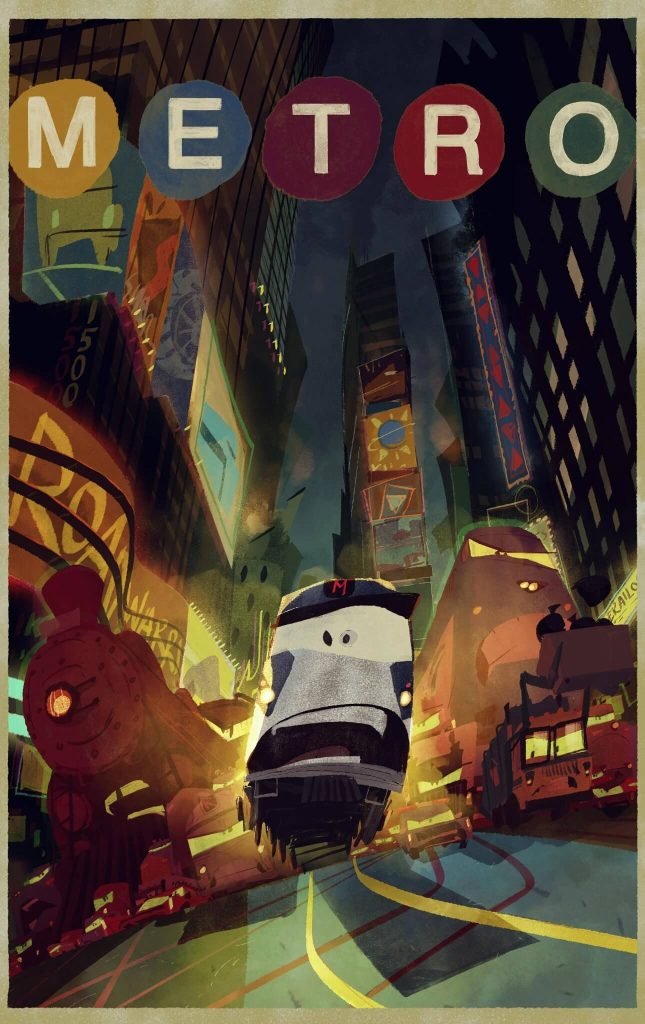
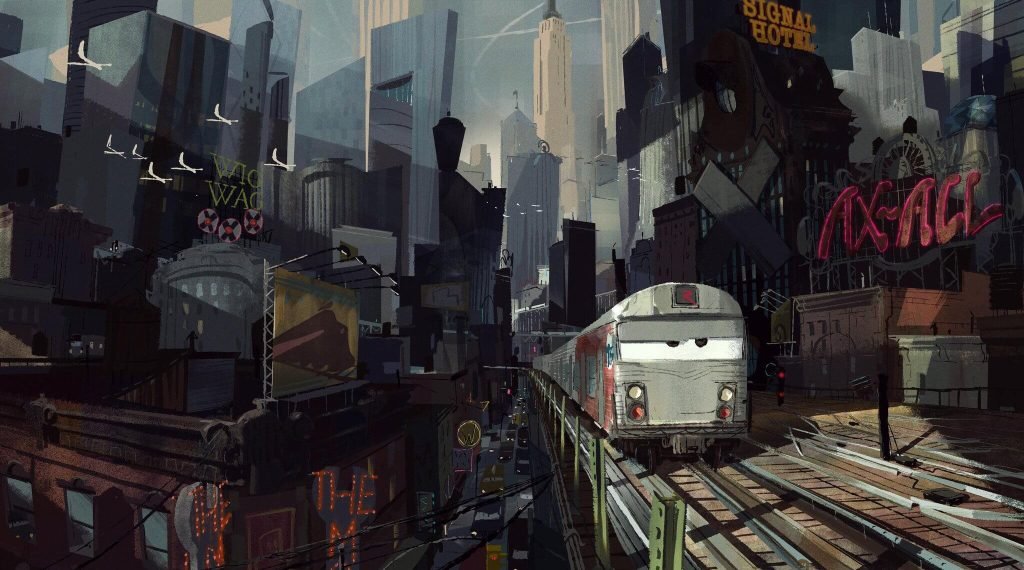
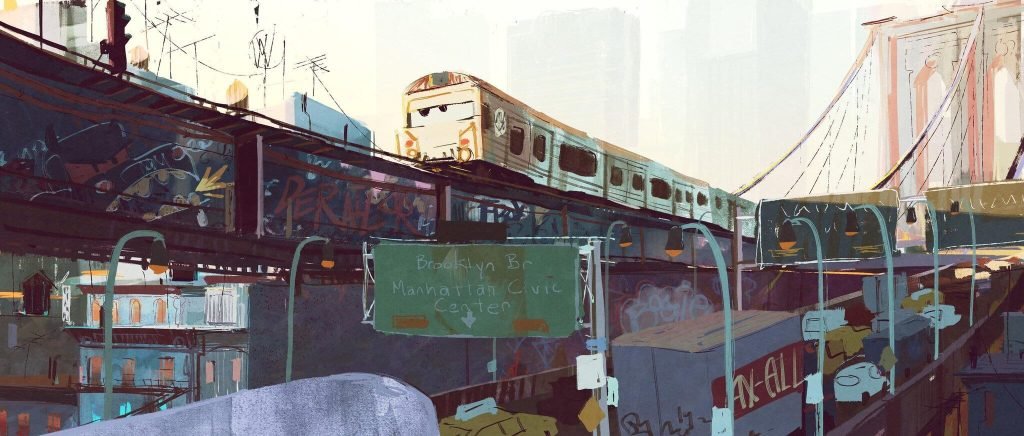
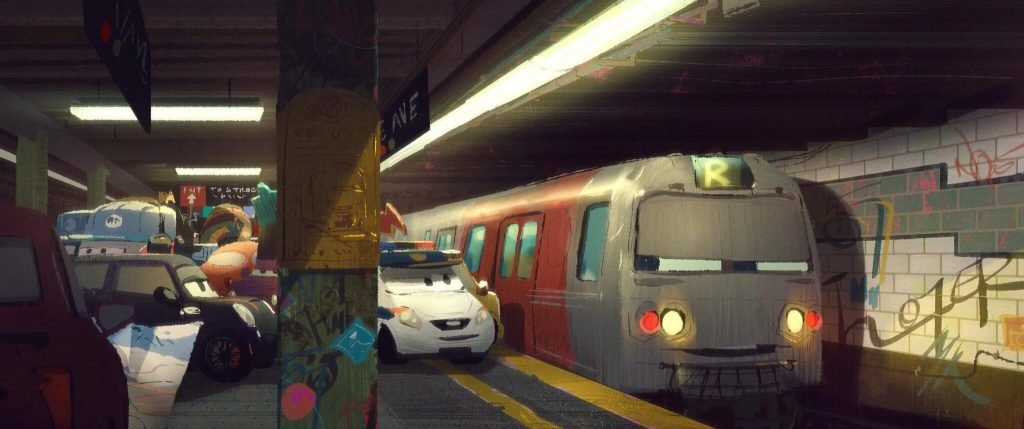
That said, it’s worth noting here that – just in the past year or so – we’ve seen Disney & Pixar attempt to expand the turf that these two characters could comfortably cover. Take – for example — “Cars on the Road,” that nine-part series which debuted on Disney+ back in September of last year. This collection of animated shorts literally sent Lightning McQueen & Mater off on a road trip.
So who knows?
Given that Bob Iger (at Disney’s quarterly earnings call held earlier this week) revealed that the Company now has sequels in the works for “Frozen,” “Toy Story,” and “Zootopia” … Well, is it really all that far-fetched to think that – at some point further on down the road – Disney & Pixar will put yet another sequel to “Cars” in the works?
One that might send Lightning McQueen & Mater off to explore the gritty inner-city world that we glimpsed in all that concept art for “Metro,” that never-produced “Cars” spin-off.
Time will tell.
-
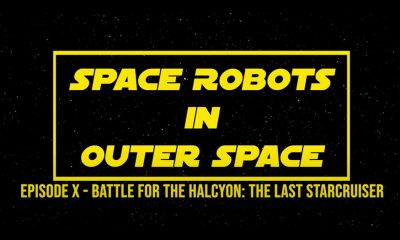
 News & Press Releases12 months ago
News & Press Releases12 months agoStar Wars Spoof: Space Robots in Outer Space Ep X: Battle for the Halcyon: The Last Starcruiser
-

 History11 months ago
History11 months ago31 Long-Gone Rides, Shows & Attractions at Disney-MGM (Hollywood Studios)
-

 News & Press Releases8 months ago
News & Press Releases8 months agoDisney Will Bring D23: The Ultimate Disney Fan Event to Anaheim, California in August 2024
-

 History4 months ago
History4 months agoFrom Birthday Wishes to Toontown Dreams: How Toontown Came to Be
-

 Theme Parks & Themed Entertainment12 months ago
Theme Parks & Themed Entertainment12 months agoFrom Aladdin to Indy – How Did We Get an Indiana Jones Stage Show at Disneyland?
-

 Theme Parks & Themed Entertainment12 months ago
Theme Parks & Themed Entertainment12 months agoHow Did We Get “Aladdin’s Oasis” at Disneyland?
-

 Theme Parks & Themed Entertainment10 months ago
Theme Parks & Themed Entertainment10 months agoWhen WDW Had a Racetrack – The Creation of the Walt Disney World Speedway
-

 Film & Movies10 months ago
Film & Movies10 months ago“Indiana Jones and the Search for Indiana Jones”








